Identification and Characteristics of Historical Extreme High-Temperature Events over the China–Pakistan Economic Corridor
Abstract
1. Introduction
2. Materials and Methods
2.1. Study Area
2.2. Data and Methods
2.2.1. Data
2.2.2. Threshold Determination by Percentile Method
2.2.3. Identification of Extreme High-Temperature Events
2.2.4. Definition of Intensity, Frequency, and Duration of Extreme High-Temperature Events
2.2.5. Generalized Pareto Distribution
2.2.6. Significance Test
3. Results
3.1. Identification Results of Extreme High-Temperature Events
3.2. Time Variation of Extreme High-Temperature Events
3.3. Spatial Variation of Extreme High-Temperature Events
3.4. Return Period Analysis
4. Discussion
5. Conclusions
Author Contributions
Funding
Institutional Review Board Statement
Informed Consent Statement
Data Availability Statement
Conflicts of Interest
References
- Lesk, C.; Rowhani, P.; Ramankutty, N. Influence of extreme weather disasters on global crop production. Nature 2016, 529, 84–87. [Google Scholar] [CrossRef] [PubMed]
- Jain, P.; Castellanos-Acuna, D.; Coogan, S.C.P.; Abatzoglou, J.T.; Flannigan, M.D. Observed increases in extreme fire weather driven by atmospheric humidity and temperature. Nat. Clim. Chang. 2022, 12, 63–70. [Google Scholar] [CrossRef]
- Arias, P.; Bellouin, N.; Coppola, E.; Jones, R.; Krinner, G.; Marotzke, J.; Naik, V.; Palmer, M.; Plattner, G.K.; Rogelj, J.; et al. Climate Change 2021: The Physical Science Basis. Contribution of Working Group I to the Sixth Assessment Report of the Intergovernmental Panel on Climate Change. In Proceedings of the 2021 Intergovernmental Panel on Climate Change AR6, Remote, 26 July–7 August 2021. [Google Scholar]
- Oudin Åström, D.; Forsberg, B.; Ebi, K.L.; Rocklöv, J. Attributing mortality from extreme temperatures to climate change in stockholm, sweden. Nat. Clim. Chang. 2013, 3, 1050–1054. [Google Scholar] [CrossRef]
- Dunne, J.P.; Stouffer, R.J.; John, J.G. Reductions in labour capacity from heat stress under climate warming. Nat. Clim. Chang. 2013, 3, 563–566. [Google Scholar] [CrossRef]
- Wernberg, T.; Smale, D.A.; Tuya, F.; Thomsen, M.S.; Langlois, T.J.; de Bettignies, T.; Bennett, S.; Rousseaux, C.S. An extreme climatic event alters marine ecosystem structure in a global biodiversity hotspot. Nat. Clim. Chang. 2013, 3, 78–82. [Google Scholar] [CrossRef]
- Palmer, T. Record-breaking winters and global climate change. Science 2014, 344, 803–804. [Google Scholar] [CrossRef]
- Hussain, M.; Butt, A.R.; Uzma, F.; Ahmed, R.; Irshad, S.; Rehman, A.; Yousaf, B. A comprehensive review of climate change impacts, adaptation, and mitigation on environmental and natural calamities in pakistan. Environ. Monit. Assess. 2020, 192, 48. [Google Scholar] [CrossRef]
- Sun, X.; Sun, Q.; Zhou, X.; Li, X.; Yang, M.; Yu, A.; Geng, F. Heat wave impact on mortality in pudong new area, china in 2013. Sci. Total Environ. 2014, 493, 789–794. [Google Scholar] [CrossRef]
- Cai, W.; Zhang, C.; Suen, H.P.; Ai, S.; Bai, Y.; Bao, J.; Chen, B.; Cheng, L.; Cui, X.; Dai, H.; et al. The 2020 china report of the lancet countdown on health and climate change. Lancet Public Health 2021, 6, e64–e81. [Google Scholar] [CrossRef]
- Wang, C.; Zheng, J.; Lin, W.; Wang, Y. Unprecedented heatwave in western north america during late june of 2021: Roles of atmospheric circulation and global warming. Adv. Atmos. Sci. 2022, 40, 14–28. [Google Scholar] [CrossRef]
- Lyon, B.; Barnston, A.G.; Coffel, E.; Horton, R.M. Projected increase in the spatial extent of contiguous us summer heat waves and associated attributes. Environ. Res. Lett. 2019, 14, 114029. [Google Scholar] [CrossRef]
- Keellings, D.; Moradkhani, H. Spatiotemporal evolution of heat wave severity and coverage across the united states. Geophys. Res. Lett. 2020, 47. [Google Scholar] [CrossRef]
- Yan, Z.; Jones, P.D.; Davies, T.D.; Moberg, A.; Bergström, H.; Camuffo, D.; Cocheo, C.; Maugeri, M.; Demarée, G.R.; Verhoeve, T.; et al. Trends of extreme temperatures in europe and china based on daily observations. Clim. Chang. 2002, 1, 355–392. [Google Scholar] [CrossRef]
- Walsh, J.E.; Phillips, A.S.; Portis, D.H.; Chapman, W.L. Extreme cold outbreaks in the United States and Europe, 1948–1999. J. Clim. 2001, 14, 2642–2658. [Google Scholar] [CrossRef]
- Wang, Y.; Ren, F.; Zhang, X. Spatial and temporal variations of regional high temperature events in china. Int. J. Climatol. 2014, 34, 3054–3065. [Google Scholar] [CrossRef]
- John, A.; Dracup; Seong, L.K.; Edwin, G.; Paulson, J. On the definition of droughts. Water Resour. Res. 1980, 16, 297–302. [Google Scholar]
- Sheffield, J.; Andreadis, K.M.; Wood, E.F.; Lettenmaier, D.P. Global and continental drought in the second half of the twentieth century: Severity–area–duration analysis and temporal variability of large-scale events. J. Clim. 2009, 22, 1962–1981. [Google Scholar] [CrossRef]
- Ren, F.; Cui, D.; Gong, Z.; Wang, Y.; Zou, X.; Li, Y.; Wang, S.; Wang, X. An objective identification technique for regional extreme events. J. Clim. 2012, 25, 7015–7027. [Google Scholar] [CrossRef]
- Cheng, J.; Tong, J.; Yanjun, W.; Jing, C.; Dongnan, J.; Lanxin, L.; Buda, S.U. A study on regional extreme precipitation events and the exposure of population and economy in china. Acta Meteorol. Sin. 2016, 74, 572–582. [Google Scholar]
- Wang, A.; Wang, Y.; Su, B.; Kundzewicz, Z.W.; Tao, H.; Wen, S.; Qin, J.; Gong, Y.; Jiang, T. Comparison of changing population exposure to droughts in river basins of the tarim and the indus. Earth’s Future 2020, 8, e2019EF001448. [Google Scholar] [CrossRef]
- Fischer, E.M.; Sippel, S.; Knutti, R. Increasing probability of record-shattering climate extremes. Nat. Clim. Chang. 2021, 11, 689–695. [Google Scholar] [CrossRef]
- Arnold, C. Death by climate change. Nat. Clim. Chang. 2022, 12, 607–609. [Google Scholar] [CrossRef]
- Grotjahn, R.; Black, R.; Leung, R.; Wehner, M.F.; Barlow, M.; Bosilovich, M.; Gershunov, A.; Gutowski, W.J.; Gyakum, J.R.; Katz, R.W.; et al. North American extreme temperature events and related large scale meteorological patterns: A review of statistical methods, dynamics, modeling, and trends. Clim. Dyn. 2016, 46, 1151–1184. [Google Scholar] [CrossRef]
- Sun, X.; Ren, G.; Shrestha, A.B.; Ren, Y.; You, Q.; Zhan, Y.; Xu, Y.; Rajbhandari, R. Changes in extreme temperature events over the Hindu Kush Himalaya during 1961–2015. Adv. Clim. Chang. Res. 2017, 8, 157–165. [Google Scholar] [CrossRef]
- Ali, S.; Eum, H.; Cho, J.; Dan, L.; Khan, F.; Dairaku, K.; Shrestha, M.L.; Hwang, S.; Nasim, W.; Khan, I.A.; et al. Assessment of climate extremes in future projections downscaled by multiple statistical downscaling methods over Pakistan. Atmos. Res. 2019, 222, 114–133. [Google Scholar] [CrossRef]
- Zeng, D.; Wu, J.; Mu, Y.; Li, H.; Deng, M.; Wei, Y.; Sun, W. An assessment of tourism climate comfort in the China–Pakistan economic corridor. Sustainability 2020, 12, 6981. [Google Scholar] [CrossRef]
- Abid, M.; Schilling, J.; Scheffran, J.; Zulfiqar, F. Climate change vulnerability, adaptation and risk perceptions at farm level in Punjab, Pakistan. Sci. Total Environ. 2016, 547, 447–460. [Google Scholar] [CrossRef]
- Ullah, S.; You, Q.; Ullah, W.; Ali, A.; Xie, W.; Xie, X. Observed changes in temperature extremes over China-Pakistan economic corridor during 1980–2016. Int. J. Climatol. 2019, 39, 1457–1475. [Google Scholar] [CrossRef]
- Li, T.; Tao, H.; Chen, J. A gridded dataset of extremely low-temperature events in the China-Pakistan economic corridor during 1961–2015. China Sci. Data 2021, 6, 33–42. [Google Scholar] [CrossRef]
- Khan, M.; Mahmood, A.; Shoaib, M. Role of ethical leadership in improving employee outcomes through the work environment, work-life quality and ICT skills: A setting of China-Pakistan economic corridor. Sustainability 2022, 14, 11055. [Google Scholar] [CrossRef]
- Shelton, S.; Dixon, R.D. Long-term seasonal drought trends in the China-Pakistan economic corridor. Climate 2023, 11, 45. [Google Scholar] [CrossRef]
- Iqbal, M.F.; Athar, H. Validation of satellite based precipitation over diverse topography of Pakistan. Atmos. Res. 2018, 201, 247–260. [Google Scholar] [CrossRef]
- Khan, N.; Shahid, S.; Ismail, T.B.; Wang, X. Spatial distribution of unidirectional trends in temperature and temperature extremes in Pakistan. Theor. Appl. Climatol. 2019, 136, 899–913. [Google Scholar] [CrossRef]
- Khan, N.; Shahid, S.; Ahmed, K.; Wang, X.; Ali, R.; Ismail, T.; Nawaz, N. Selection of GCMs for the projection of spatial distribution of heat waves in Pakistan. Atmos. Res. 2020, 233, 104688. [Google Scholar] [CrossRef]
- Chen, J.; Tao, H.; Liu, J. A daily meteorological dataset in China-Pakistan economic corridor from 1961 to 2015. Sci. Data Bank 2021, 6, 229–238. [Google Scholar]
- Zhai, P.; Pan, X. Change in extreme temperature and precipitation over northern China during the second half of the 20th century. Acta Geogr. Sin. 2003, 58, 1–10. [Google Scholar]
- Fan, L.; Yan, Z.; Chen, D.; Li, Z. Assessment of central asian heat extremes by statistical downscaling: Validation and future projection for 2015–2100. Adv. Clim. Chang. Res. 2022, 13, 14–27. [Google Scholar] [CrossRef]
- Lv, Y.; Jiang, T.; Tao, H.; Zhai, J.; Wang, Y. Spatial-temporal patterns of population exposed to the extreme maximum temperature events in the belt and road regions. Sci. Technol. Rev. 2020, 38, 68–79. [Google Scholar]
- Zheng, B.; Chenu, K.; Fernanda Dreccer, M.; Chapman, S.C. Breeding for the future: What are the potential impacts of future frost and heat events on sowing and flowering time requirements for Australian bread wheat (Triticum aestivium) varieties? Glob. Change Biol. 2012, 18, 2899–2914. [Google Scholar] [CrossRef]
- Coma, R.; Ribes, M.; Serrano, E.; Jiménez, E.; Salat, J.; Pascual, J. Global warming-enhanced stratification and mass mortality events in the Mediterranean. Proc. Natl. Acad. Sci. USA 2009, 106, 6176–6181. [Google Scholar] [CrossRef]
- Mazdiyasni, O.; Aghakouchak, A. Substantial increase in concurrent droughts and heatwaves in the United States. Proc. Natl. Acad. Sci. USA 2015, 112, 11484–11489. [Google Scholar] [CrossRef] [PubMed]
- Zhai, J.; Huang, J.; Su, B.; Cao, L.; Wang, Y.; Jiang, T.; Fischer, T. Intensity–area–duration analysis of droughts in China 1960–2013. Clim. Dyn. 2017, 48, 151–168. [Google Scholar] [CrossRef]
- Wen, S.; Wang, A.; Tao, H.; Malik, K.; Huang, J.; Zhai, J.; Jing, C.; Rasul, G.; Su, B. Population exposed to drought under the 1.5 °C and 2.0 °C warming in the Indus river basin. Atmos. Res. 2019, 218, 296–305. [Google Scholar] [CrossRef]
- Wang, A.; Lettenmaier, D.P.; Sheffield, J. Soil moisture drought in China, 1950–2006. J. Clim. 2011, 24, 3257–3271. [Google Scholar] [CrossRef]
- Lloyd-Hughes, B. A spatio-temporal structure-based approach to drought characterisation. Int. J. Climatol. 2012, 32, 406–418. [Google Scholar] [CrossRef]
- Xu, K.; Yang, D.; Yang, H.; Li, Z.; Qin, Y.; Shen, Y. Spatio-temporal variation of drought in China during 1961–2012: A climatic perspective. J. Hydrol. 2015, 526, 253–264. [Google Scholar] [CrossRef]
- El Rafei, M.; Sherwood, S.; Evans, J.P.; Ji, F. Analysis of extreme wind gusts using a high-resolution Australian regional reanalysis. Weather Clim. Extrem. 2023, 39, 100537. [Google Scholar] [CrossRef]
- Rivoire, P.; Le Gall, P.; Favre, A.; Naveau, P.; Olivia Martius, A.D. High return level estimates of daily era-5 precipitation in Europe estimated using regionalized extreme value distributions. Weather Clim. Extrem. 2022, 38, 100500. [Google Scholar] [CrossRef]
- Singirankabo, E.; Iyamuremye, E. Modelling extreme rainfall events in kigali city using generalized pareto distribution. Meteorol. Appl. 2022, 29, e2076. [Google Scholar] [CrossRef]
- Rodrigues, D.T.; Gonçalves, W.A.; Spyrides, M.H.C.; Santos E Silva, C.M.; Souza, D.O. Spatial distribution of the level of return of extreme precipitation events in northeast Brazil. Int. J. Climatol. 2020, 40, 5098–5113. [Google Scholar] [CrossRef]
- Tebaldi, C.; Strauss, B.H.; Zervas, C.E. Modelling sea level rise impacts on storm surges along us coasts. Environ. Res. Lett. 2012, 7, 14011–14032. [Google Scholar] [CrossRef]
- Mizuta, R.; Endo, H. Projected changes in extreme precipitation in a 60-km agcm large ensemble and their dependence on return periods. Geophys. Res. Lett. 2020, 47, e2019GL086855. [Google Scholar] [CrossRef]
- Raschke, M. About the return period of a catastrophe. Nat. Hazards Earth Syst. Sci. 2022, 22, 245–263. [Google Scholar] [CrossRef]
- Bastos, A.; Ciais, P.; Friedlingstein, P.; Sitch, S.; Pongratz, J.; Fan, L.; Wigneron, J.P.; Weber, U.; Reichstein, M.; Fu, Z.; et al. Direct and seasonal legacy effects of the 2018 heat wave and drought on european ecosystem productivity. Sci. Adv. 2020, 6, a2714–a2724. [Google Scholar] [CrossRef]
- El-Madany, T.S.; Carrara, A.; Martín, M.P.; Moreno, G.; Kolle, O.; Pacheco-Labrador, J.; Weber, U.; Wutzler, T.; Migliavacca, M.R. Mirco Drought and heatwave impacts on semi-arid ecosystems’ carbon fluxes along a precipitation gradient. Philos. Trans. R. Soc. B Biol. Sci. 2020, 375, 20190519. [Google Scholar] [CrossRef]
- Zampieri, M.; Russo, S.; di Sabatino, S.; Michetti, M.; Scoccimarro, E.; Gualdi, S. Global assessment of heat wave magnitudes from 1901 to 2010 and implications for the river discharge of the alps. Sci. Total Environ. 2016, 571, 1330–1339. [Google Scholar] [CrossRef]
- Yang, Z.; Yang, B.; Liu, P.; Zhang, Y.; Hou, L.; Yuan, X. Exposure to extreme climate decreases self-rated health score: Large-scale survey evidence from china. Glob. Environ. Chang. 2022, 74, 102514. [Google Scholar] [CrossRef]
- Piao, S.; Zhang, X.; Chen, A.; Liu, Q.; Lian, X.; Wang, X.; Peng, S.; Wu, X. The impacts of climate extremes on the terrestrial carbon cycle: A review. Sci. China Earth Sci. 2019, 62, 1551–1563. [Google Scholar] [CrossRef]
- Chambers, J. Global and cross-country analysis of exposure of vulnerable populations to heatwaves from 1980 to 2018. Clim. Chang. 2020, 163, 539–558. [Google Scholar] [CrossRef]
- Jones, B.; O Neill, B.C.; Mcdaniel, L.; Mcginnis, S.; Mearns, L.O.; Tebaldi, C. Future population exposure to us heat extremes. Nat. Clim. Chang. 2015, 5, 652–655. [Google Scholar] [CrossRef]
- Tuholske, C.; Caylor, K.; Funk, C.; Verdin, A.; Sweeney, S.; Grace, K.; Peterson, P.; Evans, T. Global urban population exposure to extreme heat. Proc. Natl. Acad. Sci. USA 2021, 118, e2024792118. [Google Scholar] [CrossRef] [PubMed]
- Bellprat, O.; Guemas, V.; Doblas-Reyes, F.; Donat, M.G. Towards reliable extreme weather and climate event attribution. Nat. Commun. 2019, 10, 1732. [Google Scholar] [CrossRef] [PubMed]
- Faranda, D.; Vrac, M.; Yiou, P.; Jézéquel, A.; Thao, S. Changes in future synoptic circulation patterns: Consequences for extreme event attribution. Geophys. Res. Lett. 2020, 47, e2020GL088002. [Google Scholar] [CrossRef]
- Perkins-Kirkpatrick, S.E.; Stone, D.A.; Mitchell, D.M.; Rosier, S.; King, A.D.; Lo, Y.T.E.; Pastor-Paz, J.; Frame, D.; Wehner, M. On the attribution of the impacts of extreme weather events to anthropogenic climate change. Environ. Res. Lett. 2022, 17, 24009. [Google Scholar] [CrossRef]
- Ullah, S.; You, Q.; Ullah, W.; Hagan, D.F.T.; Ali, A.; Ali, G.; Zhang, Y.; Jan, M.A.; Bhatti, A.S.; Xie, W. Daytime and nighttime heat wave characteristics based on multiple indices over the China–Pakistan economic corridor. Clim. Dyn. 2019, 53, 6329–6349. [Google Scholar] [CrossRef]
- Monteiro, J.M.; Caballero, R. Characterization of extreme wet-bulb temperature events in southern Pakistan. Geophys. Res. Lett. 2019, 46, 10659–10668. [Google Scholar] [CrossRef]
- Saleem, F.; Zeng, X.; Hina, S.; Omer, A. Regional changes in extreme temperature records over Pakistan and their relation to Pacific variability. Atmos. Res. 2021, 250, 105407. [Google Scholar] [CrossRef]
- Malik, S.M.; Awan, H.; Khan, N. Mapping vulnerability to climate change and its repercussions on human health in Pakistan. Global. Health 2012, 8, 31. [Google Scholar] [CrossRef]
- Im, E.; Pal, J.S.; Eltahir, E.A.B. Deadly heat waves projected in the densely populated agricultural regions of South Asia. Sci. Adv. 2017, 3, e1603322. [Google Scholar] [CrossRef]
- Saeed, F.; Almazroui, M.; Islam, N.; Khan, M.S. Intensification of future heat waves in Pakistan: A study using CORDEX regional climate models ensemble. Nat. Hazards 2017, 87, 1635–1647. [Google Scholar] [CrossRef]
- Aslam, A.Q.; Ahmad, S.R.; Ahmad, I.; Hussain, Y.; Hussain, M.S. Vulnerability and impact assessment of extreme climatic event: A case study of southern Punjab, Pakistan. Sci. Total Environ. 2017, 580, 468–481. [Google Scholar] [CrossRef]
- Khan, N.; Shahid, S.; Ismail, T.; Ahmed, K.; Nawaz, N. Trends in heat wave related indices in Pakistan. Stoch. Environ. Res. Risk Assess. 2019, 33, 287–302. [Google Scholar] [CrossRef]
- Saddique, N.; Khaliq, A.; Bernhofer, C. Trends in temperature and precipitation extremes in historical (1961–1990) and projected (2061–2090) periods in a data scarce mountain basin, northern Pakistan. Stoch. Environ. Res. Risk Assess. 2020, 34, 1441–1455. [Google Scholar] [CrossRef]
- Nasim, W.; Amin, A.; Fahad, S.; Awais, M.; Khan, N.; Mubeen, M.; Wahid, A.; Rehman, M.H.; Ihsan, M.Z.; Ahmad, S.; et al. Future risk assessment by estimating historical heat wave trends with projected heat accumulation using SimCLIM climate model in Pakistan. Atmos. Res. 2018, 205, 118–133. [Google Scholar] [CrossRef]
- Herring, S.C.; Hoell, A.; Hoerling, M.P.; Kossin, J.P.; Iii, C.J.S.; Stott, P.A. Explaining extreme events of 2015 from a climate perspective. Bull. Amer. Meteorol. Soc. 2016, 97, S1–S145. [Google Scholar] [CrossRef]
- Masood, I.; Majid, Z.; Sohail, S.; Zia, A.; Raza, S. The deadly heat wave of Pakistan, June 2015. Int. J. Occup. Environ. Med. 2015, 6, 247–248. [Google Scholar] [CrossRef]
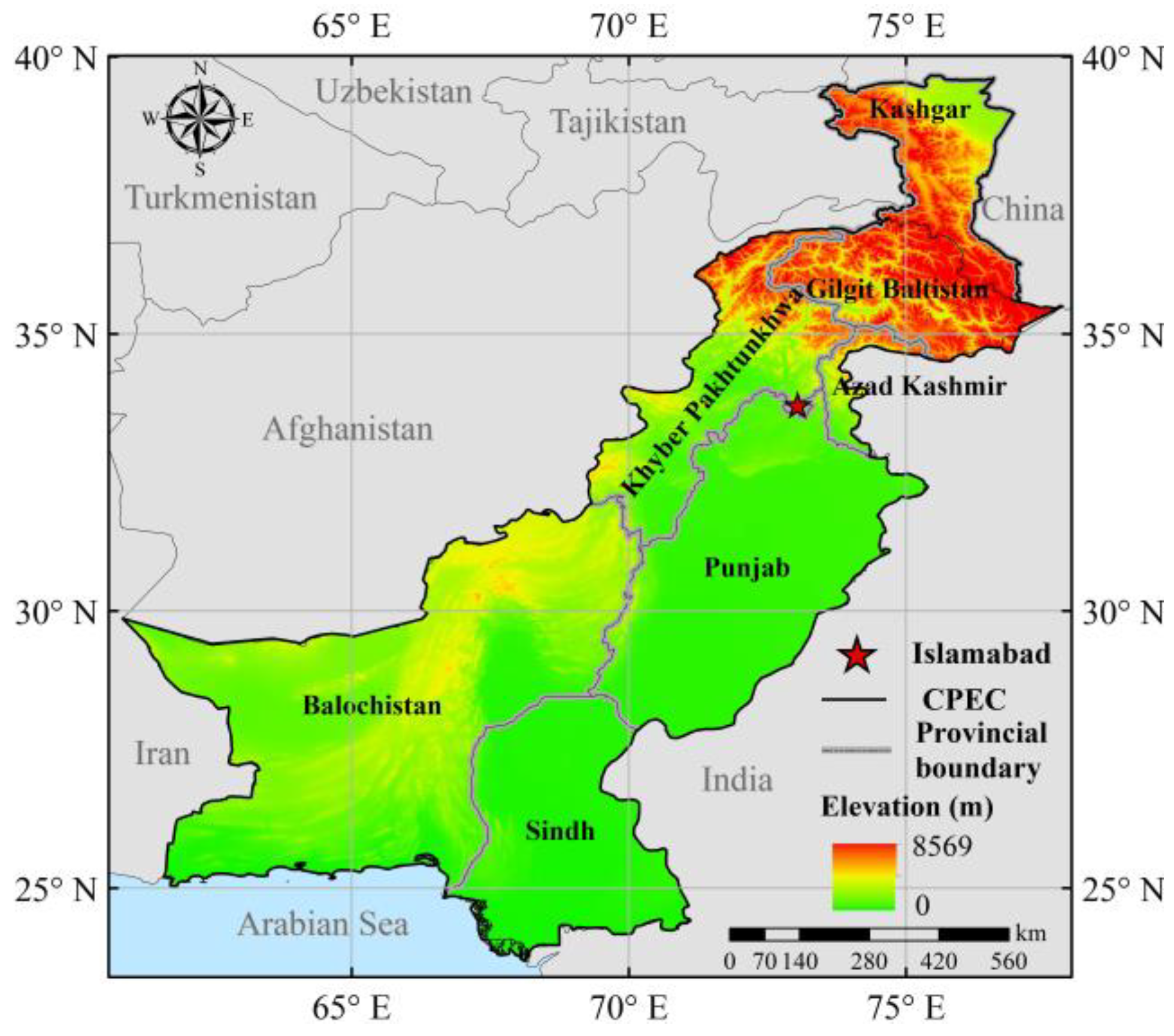
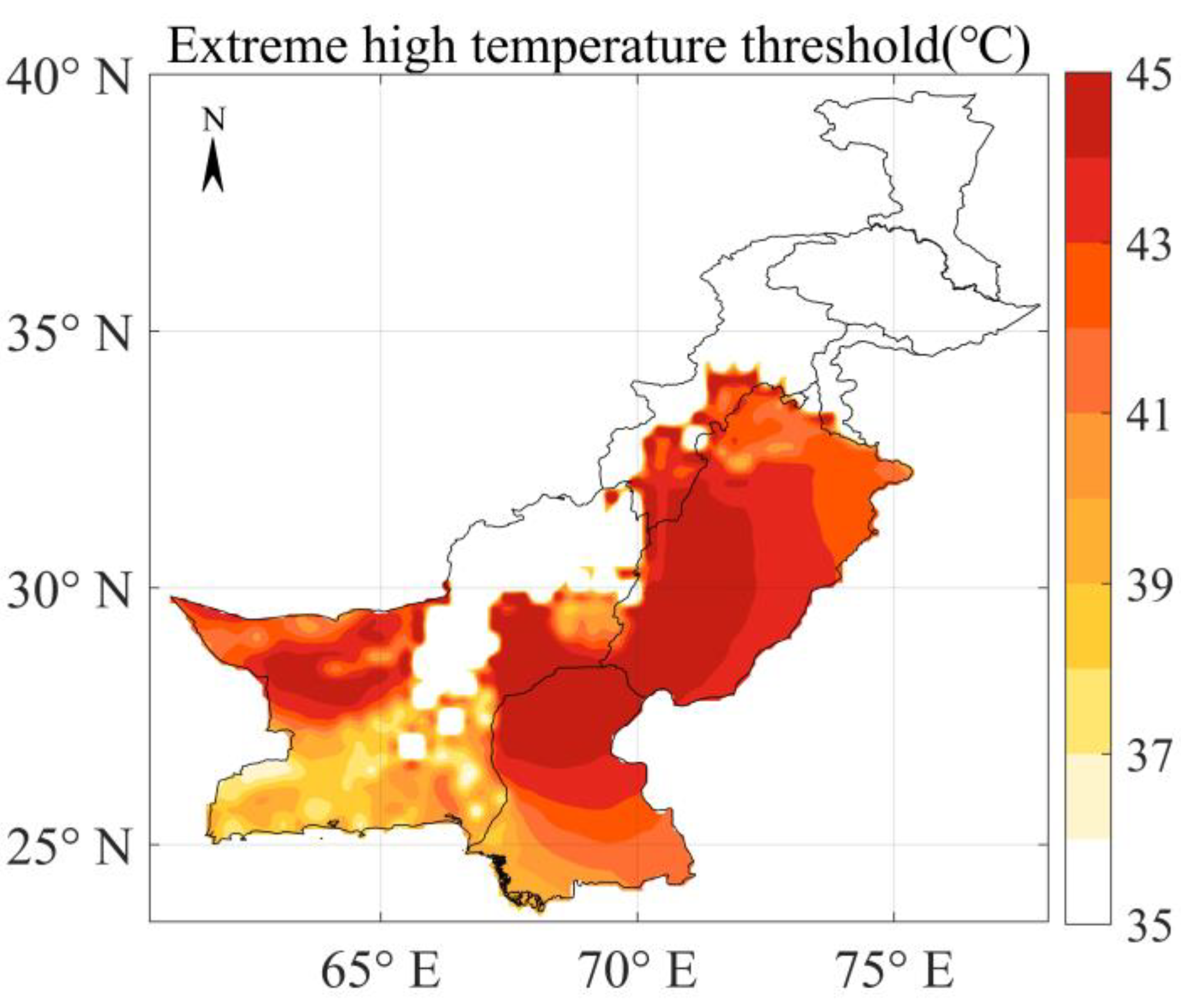
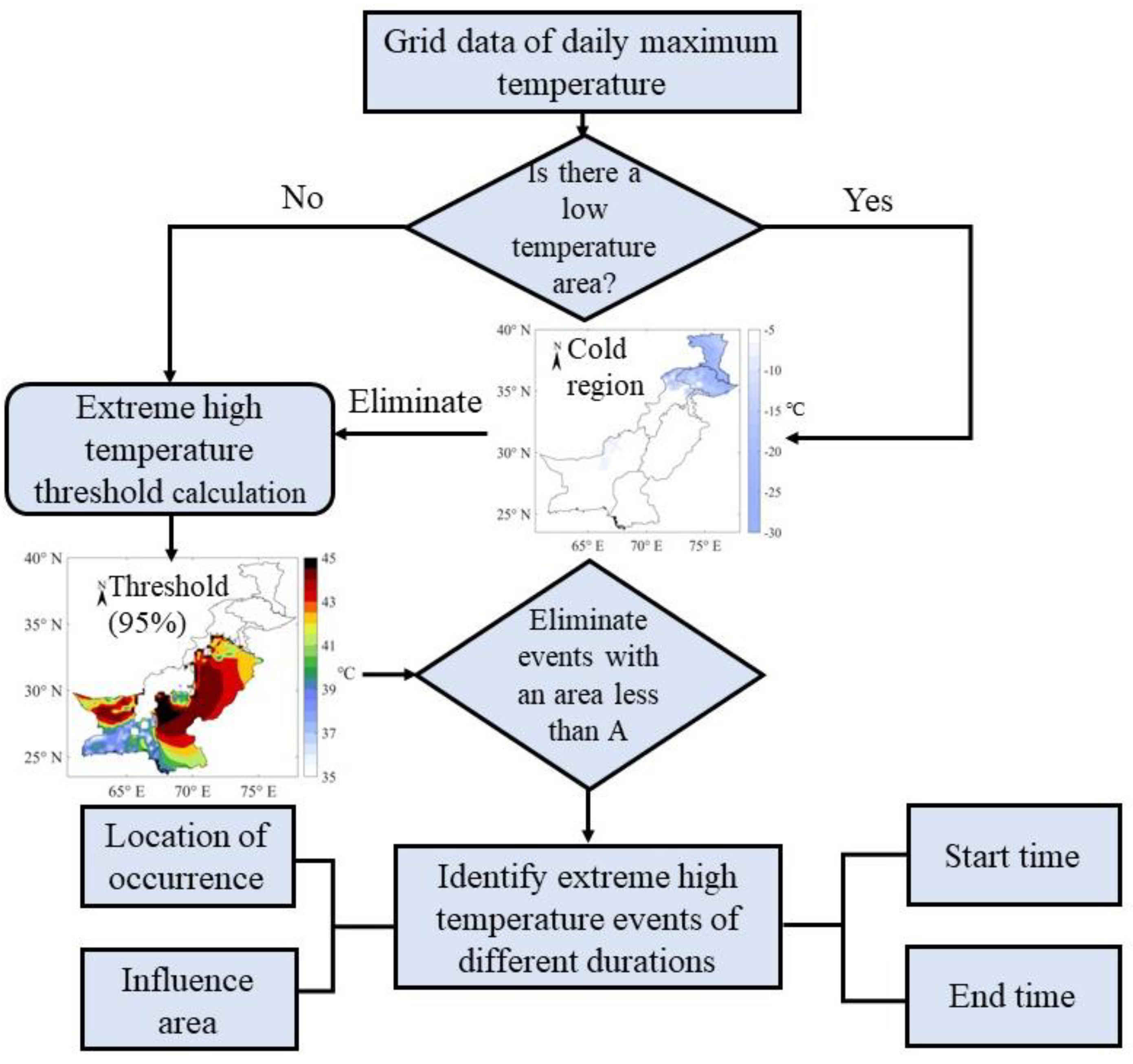
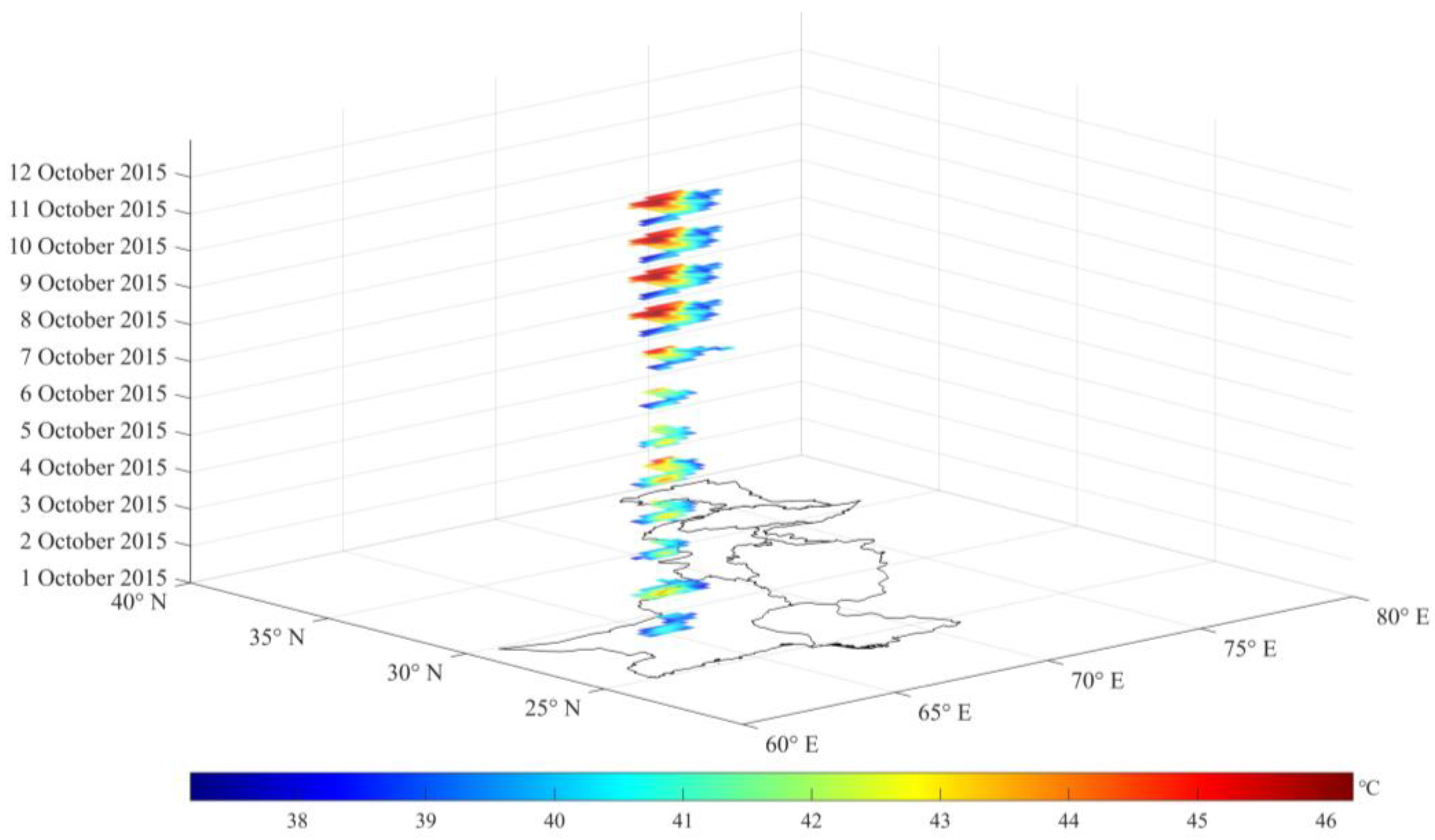


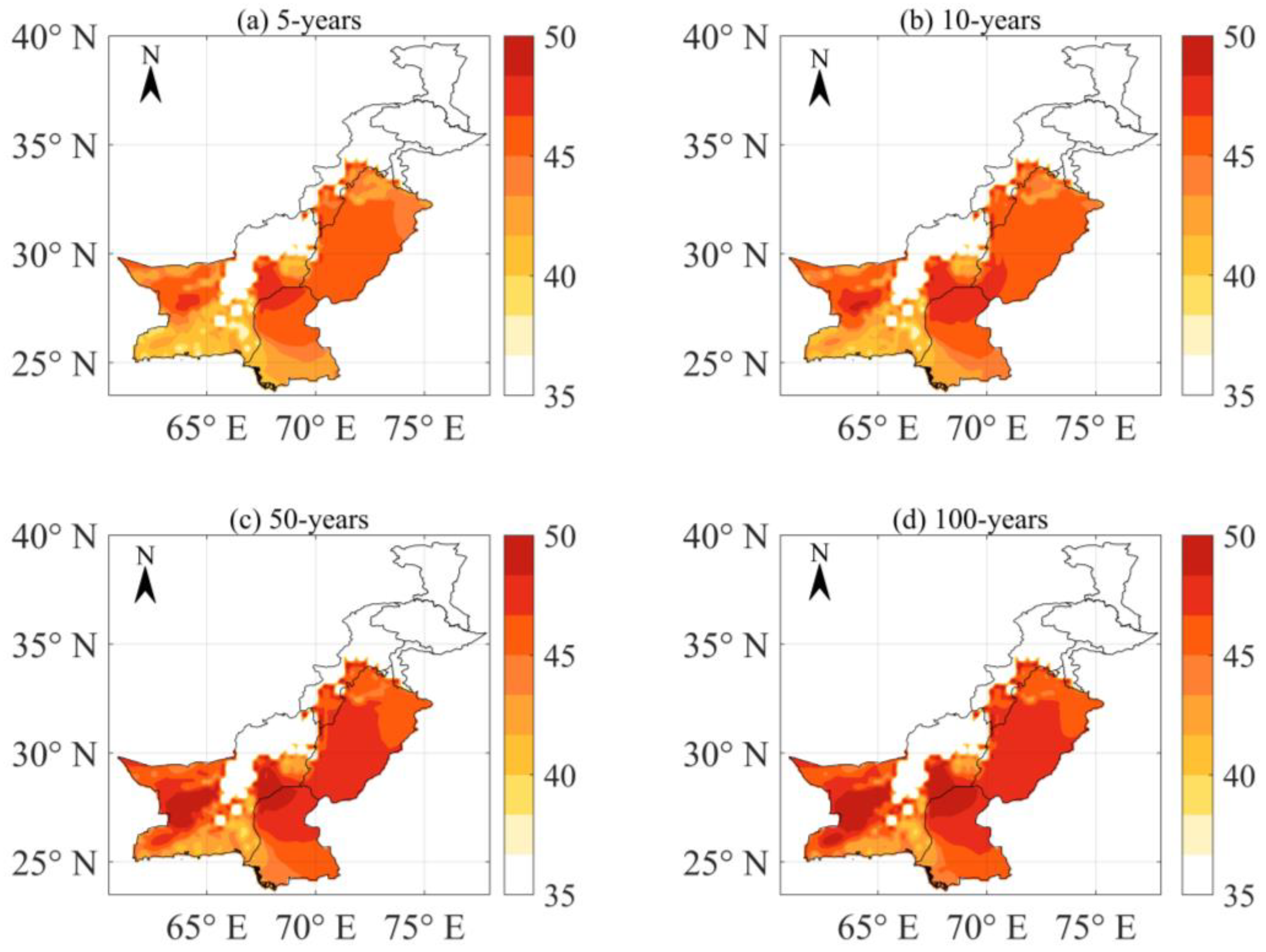
| Essential Factor | Definition | Units |
|---|---|---|
| Strength | The intensity is the annual average maximum temperature of extreme high-temperature events | ℃ |
| Frequency | The frequency is the annual average number of extreme high-temperature events | times |
| Duration | The duration is the annual average duration of extreme high-temperature events | days |
| Serial Number | Extreme High-Temperature Events | |
|---|---|---|
| Start and End Time | Duration (days) | |
| 1 | 1 May 1978–25 May 1978 | 25 |
| 2 | 2 June 1979–21 June 1979 | 20 |
| 3 | 27 May 1982–16 June1982 | 21 |
| 4 | 16 May 1984–11 June 1984 | 27 |
| 5 | 8 May 1989–27 May 1989 | 21 |
| 6 | 5 June 1992–24 June 1992 | 20 |
| 7 | 25 May 1995–9 June 1995 | 16 |
| 8 | 29 May 2003–17 June 2003 | 20 |
| 9 | 11 May 2010–2 June 2010 | 23 |
| 10 | 12 May 2011–23 May 2011 | 11 |
| 12 | 19 July 2013–31 July 2013 | 13 |
| 13 | 20 May 2014–2 July 2014 | 44 |
| 14 | 20 June 2015–12 July 2015 | 30 |
| 15 | 1 October 2015–12 October 2015 | 12 |
Disclaimer/Publisher’s Note: The statements, opinions and data contained in all publications are solely those of the individual author(s) and contributor(s) and not of MDPI and/or the editor(s). MDPI and/or the editor(s) disclaim responsibility for any injury to people or property resulting from any ideas, methods, instructions or products referred to in the content. |
© 2023 by the authors. Licensee MDPI, Basel, Switzerland. This article is an open access article distributed under the terms and conditions of the Creative Commons Attribution (CC BY) license (https://creativecommons.org/licenses/by/4.0/).
Share and Cite
Li, T.; Bao, A. Identification and Characteristics of Historical Extreme High-Temperature Events over the China–Pakistan Economic Corridor. Atmosphere 2023, 14, 530. https://doi.org/10.3390/atmos14030530
Li T, Bao A. Identification and Characteristics of Historical Extreme High-Temperature Events over the China–Pakistan Economic Corridor. Atmosphere. 2023; 14(3):530. https://doi.org/10.3390/atmos14030530
Chicago/Turabian StyleLi, Tao, and Anming Bao. 2023. "Identification and Characteristics of Historical Extreme High-Temperature Events over the China–Pakistan Economic Corridor" Atmosphere 14, no. 3: 530. https://doi.org/10.3390/atmos14030530
APA StyleLi, T., & Bao, A. (2023). Identification and Characteristics of Historical Extreme High-Temperature Events over the China–Pakistan Economic Corridor. Atmosphere, 14(3), 530. https://doi.org/10.3390/atmos14030530








